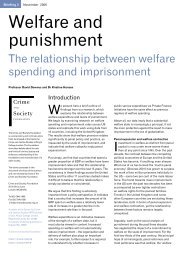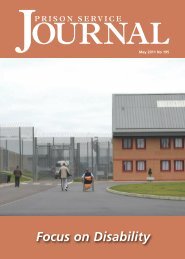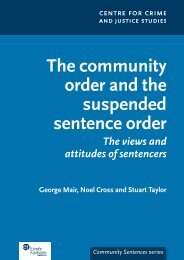PRISON SERVICE
PRISON SERVICE
PRISON SERVICE
- No tags were found...
You also want an ePaper? Increase the reach of your titles
YUMPU automatically turns print PDFs into web optimized ePapers that Google loves.
The Alcohol Dependency Treatment Programme(ADTP) is a six-week, intensive offending behaviourprogramme aimed at medium — to high-risk maleoffenders with a history of alcohol dependence. TheADTP introduces coping and relapse-preventions skills,addresses skills deficits that underlie both alcoholdependence and violent offending; the programmeactively links participants to ongoing sources of supportsuch as Alcoholics Anonymous (AA), and guidesparticipants in need of ongoing support on release intoappropriate community programme. The ADTP wasdeveloped by the Rehabilitation for Addicted PrisonersTrust (RAPt) and accredited by the Correctional ServiceAccreditation Panel (CSAP) in 2008.A twelve-step approach forms the basis of theADTP because this approach has been shown to beparticular effective for offenders with severe levels ofdependence and low levels of social support 10 .Additionally, the approach has been shown to increasethe likelihood of successful engagement withAlcoholics Anonymous (AA) 11 Alcoholics Anonymousprovides an ongoing, free, nationwide, readily availablenetwork of support which is independent of thecriminal justice system, yet accessible both in prison andin the community. Such support is a crucial source ofsupport, offering continuity between treatment, prisonand the transition back into the community. It is alsoimportant for alcohol dependent offenders because itprovides a network of sober friends outside of prison ina society which is otherwise widely accepting of alcoholuse.The source of data used in this paper comes fromtwelve consecutive cohorts of participants on the ADTPat HMP Bullingdon between April 2007 and January2009. There were a total of 134 participants during thisperiod; 107 graduated and 27 were de-selected.Despite the small sample size, the findings areencouraging: A comparison of pre- and post-treatmentpsychometric scores indicates the programme producessignificant changes across a range of dynamic riskfactors for re-offending. Participants’ post-treatmentfeedback also indicates the programme is effective inlinking offenders to peer and professional support andincreasing the likelihood of affiliation with thefellowship of Alcoholics Anonymous (AA).MethodParticipant SelectionAll applicants undergo a ComprehensiveSubstance Misuse Assessment (CSMA) prior to beingassessed further for the ADTP. This includesquestionnaires covering the offender’s drug and alcoholhistory, social support, history of mental healthproblems and other treatment-related needs.Applicants’ eligibility for the ADTP is then assessedaccording to the following criteria: Medium-high risk of re-offending A history of alcohol dependence Alcohol dependence as a significant risk factor forre-offendingRisk of re-offending is assessed through the OASysassessment where it is operational within theestablishment. Alternatively, the sentence planningprocess using the sentence planning risk predictor willbe used.History of alcohol dependence is assessed usingRAPt’s Substance Dependence Assessment and theCSMA. The RAPt Substance Dependence Assessmentevaluates whether an offender meets DSM-IV-TRcriteria for alcohol dependence. The CSMA providesmore general information, through open-endedquestions, about the offender’s use of alcohol.Where someone has been assessed as meetingDSM-IV criteria for alcohol dependence, theirdependence will be assumed to be a significant riskfactor for re-offending even if it was not a factor in anyof their previous crimes. However, applicants with aclear history of alcohol-related offending are givenpriority.A range of measures are used to assessparticipants before they begin treatment: Prison and Probation Offender AssessmentSystem (OASys) CARAT’s Comprehensive Substance MisuseAssessment (CSMA) The RAPt Assessment and Mental Health Screen(RAPt Assessment) Part One: Participant Information(Demographic information, offending historyand drug use history) Part Two: Substance DependenceAssessment Part Three: Mental Health Screen University of Rhode Island Change Assessment(URICA) — Administered pre- and post-treatment Alcohol Taking Confidence Questionnaire (ATCQ)— Administered pre- and post-treatment Drug Taking Confidence Questionnaire (DTCQ) —Administered pre- and post-treatment10. Project MATCH Research Group (1997) Matching alcoholism treatments to client heterogeneity: Project MATCH post-treatmentoutcomes. Journal of Studies on Alcohol, 58, 7-29.11. For example see Fiorentine, R. and Hillhouse, M.P. (2000) Drug treatment and 12-step program participation: The additive effects ofintegrated recovery activites. Journal of Substance Abuse Treatment, 18, 65-74 and Kelly, J.F. (2003) Self-help for substance-usedisorders: History, effectiveness, knowledge gaps, and research opportunities. Clinical Psychology Review, 23, 639-663.10 Prison Service JournalIssue 192











